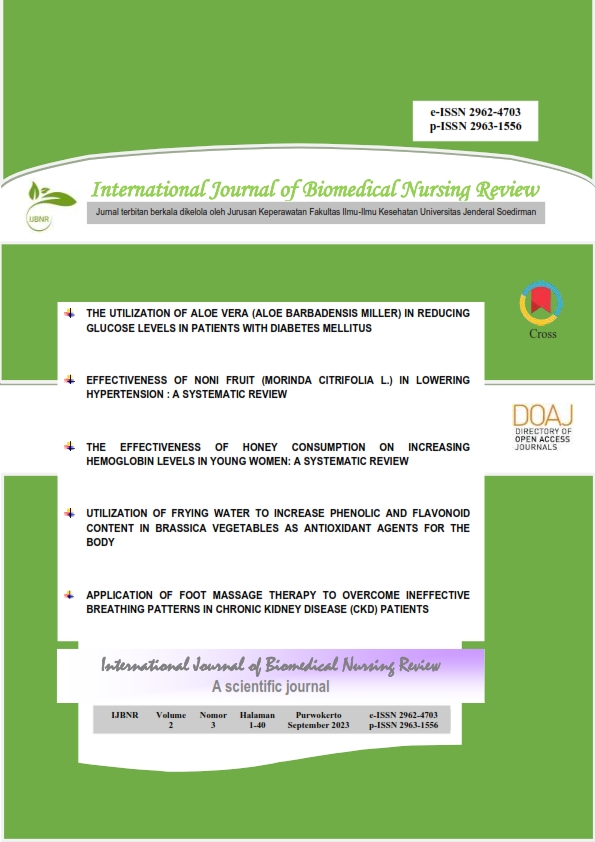Utilization of Frying Water to Increase Phenolic and Flavonoid Content in Brassica Vegetables As Antioxidant Agents for The Body
English
Abstract
Background: Brassica vegetables are a type of vegetable that is easy to find and widely consumed by people in Indonesia because of their high variety and relatively cheap prices. Brassica vegetables such as cauliflower, broccoli, kale, and sprouts have a high antioxidant content due to their phenolic compounds. In general, Brassica vegetables are not consumed raw but through processing. The antioxidant compounds contained in brassica can be known depending on the processing method used. Various processing methods, one of which is the processing method using Air Frying.
Objective: The purpose of this Systematic Review study was to examine the use of Air Frying in Brassica vegetables to increase the content of phenolic compounds and flavonoids.
Method: The design used in this study is a systematic literature review (SLR) using the preferred Reporting Items for Systematic Review and Meta-analyses (PRISMA) method by searching journals in electronic databases published on Google Scholar, Pubmed, and Science Direct, which have been published since from 2013 to 2023. These articles were then extracted by paying attention to the titles and abstracts to see their suitability for the topics discussed.
Results: The 5 selected articles show that hot air frying technology makes the nutritional quality of food higher than conventional frying, and becomes a practical alternative for getting healthier fried foods because of the possibility of reducing fat, lipid degradation, and oxidation. Air frying is becoming a more suitable processing method for processing brassica vegetables. Frying with high-temperature air for a short time will prevent the nutritional content of vegetables during processing. Air fryers are capable of significantly increasing the TFC and TPC of brassica vegetables regardless of the variety.
Conclusion: The application of Air Frying improves the phenolic and flavonoid status and antioxidant potential of selected Brassica Vegetables.
References
Ahmad Jan, S. (2018) ‘Antioxidant and anticancer activities of Brassica rapa: a review’, MOJ Biology and Medicine, 3(4), pp. 3–7. Available at: https://doi.org/10.15406/mojbm.2018.03.00094.
Armesto, J. et al. (2019) ‘Effects of different cooking methods on the antioxidant capacity and flavonoid, organic acid and mineral contents of Galega Kale (Brassica oleracea var. acephala cv. Galega)’, International Journal of Food Sciences and Nutrition, 70(2), pp. 136–149. Available at: https://doi.org/10.1080/09637486.2018.1482530.
Becker, T. and Juvik, J. (2016) ‘The Role of Glucosinolate Hydrolysis Products from Brassica Vegetable Consumption in Inducing Antioxidant Activity and Reducing Cancer Incidence’, Diseases, 4(4), p. 22. Available at: https://doi.org/10.3390/diseases4020022.
Bhandari, S.R. and Kwak, J.H. (2015) ‘Chemical composition and antioxidant activity in different tissues of brassica vegetables’, Molecules, 20(1), pp. 1228–1243. Available at: https://doi.org/10.3390/molecules20011228.
Fikry, M. et al. (2022) ‘ Development of Mathematical Models for Predicting Mass Transfer and Changes in Quality Properties of Falafel Prepared from Faba Bean ( Vicia faba L.) by Air Frying Technique ’, Journal of Biobased Materials and Bioenergy, 16(1), pp. 150–158. Available at: https://doi.org/10.1166/jbmb.2022.2162.
Hamed, M. et al. (2019) ‘Capsaicinoids, polyphenols and antioxidant activities of Capsicum annuum: Comparative study of the effect of ripening stage and cooking methods’, Antioxidants, 8(9). Available at: https://doi.org/10.3390/antiox8090364.
Hossain, A. et al. (2017) ‘Enhancement of antioxidant quality of green leafy vegetables upon different cooking method’, Preventive Nutrition and Food Science, 22(3), pp. 216–222. Available at: https://doi.org/10.3746/pnf.2017.22.3.216.
Jin, X. et al. (2014) ‘Impact of different drying trajectories on degradation of nutritional compounds in broccoli (Brassica oleracea var. italica)’, Lwt, 59(1), pp. 189–195. Available at: https://doi.org/10.1016/j.lwt.2014.05.031.
Mahanta, C. (2012) ‘Effect of steaming, boiling and microwave cooking on the total phenolics, flavonoids and antioxidant properties of different vegetables of Assam, India’. Available at: www.ijfans.com/currentissue.html.
Maqbool, N. et al. (2021) ‘Cooking methods affect eating quality, bio-functional components, antinutritional compounds and sensory attributes of selected vegetables’, Italian Journal of Food Science, 33(SP1), pp. 150–162. Available at: https://doi.org/10.15586/IJFS.V33ISP1.2092.
Murzaini, N.M.N. et al. (2020) ‘Effect of pre-treatment in producing pumpkin powder using air fryer and its application in “Bingka” baking’, Current Research in Nutrition and Food Science, 8(1), pp. 48–64. Available at: https://doi.org/10.12944/CRNFSJ.8.1.05.
Nandasiri, R. et al. (2023) ‘Thermal Processing via Air Frying Improves the Antioxidant Properties of Brassica Vegetables’, (February), pp. 1–20. Available at: https://doi.org/10.20944/preprints202302.0021.v1.
Negara, B.F.S.P. et al. (2021) ‘Article application of deep, vacuum, and air frying methods to fry chub mackerel (Scomber japonicus)’, Processes, 9(7), pp. 1–14. Available at: https://doi.org/10.3390/pr9071225.
O. Mwebi, N. and M.O. Ogendi, B. (2020) ‘Effect of boiling, steaming, stir-frying and microwave cooking on the antioxidant potential of peppers of varying pungency’, Cogent Food and Agriculture, 6(1). Available at: https://doi.org/10.1080/23311932.2020.1834661.
Schmiedeskamp, A., Schreiner, M. and Baldermann, S. (2022) ‘Impact of Cultivar Selection and Thermal Processing by Air Drying, Air Frying, and Deep Frying on the Carotenoid Content and Stability and Antioxidant Capacity in Carrots (Daucus carota L.)’, Journal of Agricultural and Food Chemistry, 70(5), pp. 1629–1639. Available at: https://doi.org/10.1021/acs.jafc.1c05718.
Solanum, L. et al. (2021) ‘Effect of Air-Frying on the Bioactive Properties of Eggplant’.
Wang, Y. et al. (2021) ‘Effect of new frying technology on starchy food quality’, Foods, 10(8). Available at: https://doi.org/10.3390/foods10081852.
Zaghi, A.N. et al. (2019) ‘Frying Process: From Conventional to Air Frying Technology’, Food Reviews International, 35(8), pp. 763–777. Available at: https://doi.org/10.1080/87559129.2019.1600541.
Zhu, Z. et al. (2021) ‘Air frying combined with grape seed extract inhibits Nε-carboxymethyllysine and Nε-carboxyethyllysine by controlling oxidation and glycosylation’, Poultry Science, 100(2), pp. 1308–1318. Available at: https://doi.org/10.1016/j.psj.2020.11.056.








 Kampus keperawatan unsoed
Kampus keperawatan unsoed 

